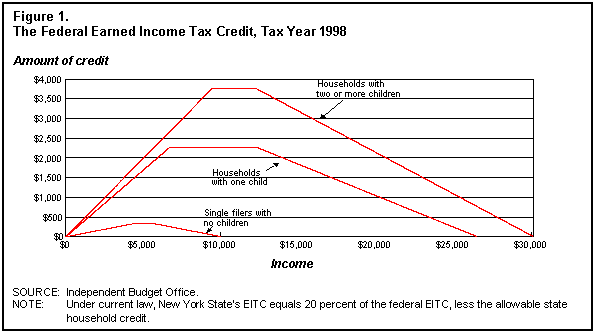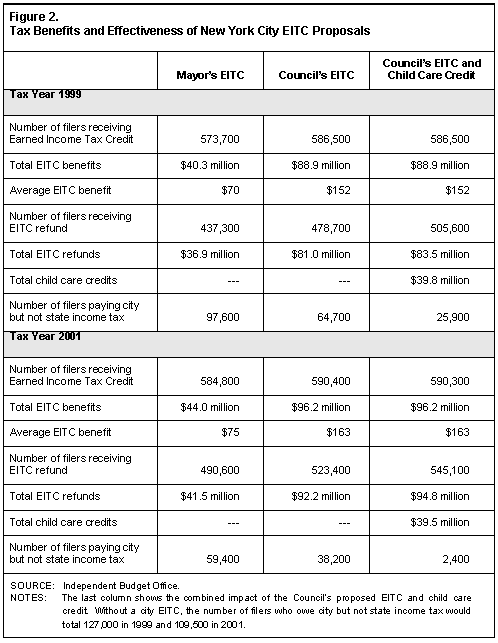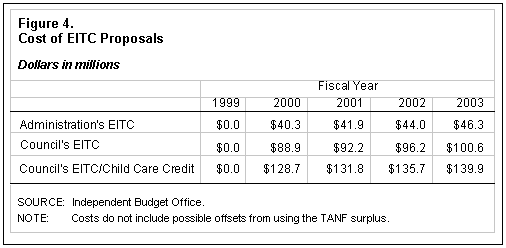 Brief
Brief
 Brief
Brief
Tax Relief for the Working Poor:
Proposals for an Earned Income Tax Credit
Large numbers of working poor New Yorkers are burdened by city personal income tax liability, even though their incomes are low enough to escape state and federal income taxes. Taxing the income of households struggling to escape poverty strikes many observers as unfair. Moreover, these taxes are likely to be counterproductive, decreasing incentives for labor force participation and making it more difficult to move welfare recipients into the paid workforce. In response to this problem, both the Administration and the City Council have recently proposed creating a refundable earned income tax credit (EITC) for low-income city residents. This fiscal brief analyzes the costs and benefits of the two proposals. Our principal findings include:
This fiscal brief begins with a discussion of federal and state earned income tax credits and then examines the extent to which New York City taxes the working poor. The next section examines the alternative proposals for a city EITC, including the costs and benefits of each proposal. The final section looks at the possible use of New York State's TANF surplus to fund a portion of a city earned income tax credit.
|
May 1999
EITCs and the Working PoorThe federal earned income tax credit. The earned income tax credit is a form of tax relief for low-income, working Americans designed to increase incentives for labor force participation. As such, an EITC would complement efforts to move public assistance recipients into the paid workforce.
The incentive for labor force participation results from the structure of the EITC (see Figure 1). For the lowest-income working households, the amount of the credit increases as income from work increases. For the 1998 tax year, for example, a household with two or more children received an EITC against federal income tax liability of 40 cents for every dollar earned up to $9,390óthe annual income level at which the credit reached its maximum value of $3,756. The federal EITC remained at the maximum for income levels up to $12,260 and then declined at a rate of roughly 21 cents for each additional dollar earned until it phased out entirely for incomes above $30,095. Filers with one or no children received smaller maximum credits that phased out at a lower level of income.
These income thresholds and credit amounts are adjusted by the federal government each year for inflation (as measured by the U.S. consumer price index), so that the value of the credit does not erode over time. The federal EITC is refundable, meaning that if the value of the credit exceeds pre-credit tax liability, the remaining credit is refunded to the tax filer as a lump-sum payment after the end of the year.
New York Stateís EITC. New York State is one of ten states that also offer EITCs. Since 1996, New York tax filers have been able to claim an EITC against state income taxes equal to 20 percent of the federal EITCóup from 7.5 percent of the federal credit in 1994 and 10 percent in 1995.1 Like the federal credit, New York Stateís EITC is refundable. Because the state EITC is based on a percentage of the federal credit, it is automatically adjusted for inflation each year, easy for the state to administer, and readily available to taxpayers.
Taxing the working poor. The increasing generosity of the federal and state EITCs, coupled with erosion in the value of the cityís household credit for low-income filers over time due to inflation, has created a growing problem for New York Cityís working poor. A large number of city households who are too poor to pay any state or federal income tax are burdened with the cityís tax on personal income (PIT).2 While the phase-in of the stateís School Tax Relief (STaR) PIT credit and rate reduction and the recent expiration of the cityís 12.5 percent PIT surcharge will remove a number of New Yorkers from the city tax rolls, a significant number of low-income residents will continue to pay city but not state and federal taxesó127,000 in the current tax year.
Besides the federal and state EITCs, another factor contributing to some New Yorkers having to pay city but not state income taxes is the child care credit available to state taxpayers.3 The state child care credit is a percentage of the allowable federal credit, where the allowable credit varies with income. No such credit exists on the city level. Not surprisingly, IBOís 1998 analysis (see footnote 2) found that the most effective way to eliminate the working poor from the cityís tax rolls would be to institute a city child care credit in conjunction with an EITC.

A City Earned Income Tax Credit
Proposals for a city EITC.
Both the City Council and the Mayor have recently proposed refundable EITCs beginning in tax year 1999. In his executive budget, the Mayor called for a city EITC equal to 25 percent of the state credit. The Administrationís proposal also called for using a portion of the stateís surplus from the federal Temporary Assistance to Needy Families (TANF) grant program to fund most of the EITCís cost. The Councilís proposal, presented in their March response to the Mayorís preliminary budget, is for a city EITC equal to 50 percent of the state EITCóroughly double the amount of the Administrationís.4 The Council also proposed a local child care credit equal to 50 percent of the existing state child care credit.On the state level, there are proposals for New York State to increase its own EITC from 20 to 30 percent of the federal credit, with some proponents eyeing the TANF surplus as a means to offset the stateís cost. Because both the Mayorís and the City Councilís proposals are based on the state credit, an enhancement of the state EITC could increase the cost of either proposal and claim additional TANF surplus funds.
Comparing the benefits. Using the most recent sample of over 50,000 New York personal income tax returns of both resident and non-resident city filers, IBO has simulated the tax-reduction benefits and effectiveness of both the Administrationís and the Councilís EITC proposals. Figure 2 reports key findings for 1999óthe first year in which the EITC would be offeredóand 2001, the year in which the phase-in of STaRís PIT reductions will be complete based on New York Stateís current EITC.
Because both proposals for a city EITC would piggyback on the state credit, the number of tax filers who would benefit in 1999 is roughly the same under either proposaló573,700 for the Mayorís compared with 586,500 for the Councilís.5 In contrast, the tax benefits received by the working poor would differ substantially between the two proposals. Because the Councilís proposal calls for an EITC that is twice as large as the Mayorís, total tax savings and refunds under the Councilís plan are also roughly double the benefits under the Administration proposal. Under the Mayorís proposal and with the state EITC remaining at 20 percent of the federal credit, low-income New Yorkers would receive a total of $40.3 million in combined tax reductions and refunds in the current year, with an average benefit per filer of $70. If the Councilís more generous proposal is enacted, total EITC benefits would reach $88.9 million in 1999, with an average benefit of $152. The Councilís proposed child care credit would provide an additional $39.8 million of tax breaks bringing the total to $128.7 million.

Under either proposal, the value of EITC benefits beyond that used to reduce or eliminate pre-credit personal income tax liability would be received by taxpayers in the form of refund checks. Most households taking the EITC would receive a refundó437,300 filers would obtain a total of $36.9 million in EITC refunds in 1999 under the Administrationís proposal, compared with 478,700 filers who would receive $81.0 million under the Councilís proposal.6
New Yorkers paying city but not state PIT. If a city EITC is not adopted this year, IBO projects that 127,000 households will be burdened by city personal income tax liability, even though their incomes are low enough to escape state and federal taxes. An EITC against city personal income tax liability would remove a significant number of these working poor from the cityís tax rolls. If the Administrationís EITC proposal is adopted, 97,600 households will pay city but not state taxes in 1999. In contrast, the number of filers remaining on only the cityís tax rolls would fall to 64,700 if the Councilís EITC is adopted. Moreover, if the Councilís proposals for both an EITC and a non-refundable child care credit (equal to 50 percent of the existing state credit) are adopted, the combination of tax credits would eliminate many more filers who do not incur state liability from the cityís tax rollsóonly 25,900 households would pay city but not state income taxes in 1999.
With or without a city EITC, the phase-in of personal income tax credits and rate reductions under the STaR program is expected to decrease the number of working poor on the cityís tax rolls over the next few years. (See Figure 3.) Without a city EITC, about 109,500 households would pay city but not state income tax in 2001 when STaRís benefits are fully phased inóabout 14 percent fewer households than currently. Adoption of the Administrationís proposal for a city EITC would reduce the number of households with city but not state tax liability in 2001 to 59,400. In contrast, adoption of the Councilís EITC proposal would reduce the number of households on only the cityís tax rolls in 2001 to 38,200, while the addition of the child care credit would reduce the number of households still further to 2,400.

The impact of changes in state tax policy. Recent proposals to increase New York Stateís EITC from 20 percent to 30 percent of the federal credit starting in 1999, if enacted, could make a city EITC more generous. The number of households receiving a city EITC would increase only slightly. Not surprisingly, however, the total value of city EITC benefits provided under either the Administrationís or Councilís proposals would increaseóby somewhat more than one-half. Moreover, with an enhanced state EITC, more low-income New Yorkers would no longer pay state income taxes; without a city EITC (or some other form of targeted tax relief), an increase in the stateís EITC would cause the number of households paying city but not state income taxes to increase compared with current law projections to 150,900 in 1999 and 134,900 in 2001.
Comparing the costs. Assuming that New York Stateís EITC remains equal to 20 percent of the federal credit, the cost of the Administrationís and the Councilís EITC proposals from fiscal years 1999 to 2003, plus the combined cost of the Councilís EITC and child care credit package are shown in Figure 4. The figures do not incorporate the budgetary offset that would occur if the city could fund part of its EITC with New York Stateís TANF surplus.
While both the Administrationís and Councilís proposals call for instituting an EITC in tax year 1999, the budgetary impact would not be felt until city fiscal year 2000. The Administrationís proposal is the least costlyó$40.3 million in fiscal year 2000 growing to $46.3 million by 2003. The cost of the Councilís EITC proposal is a little more than double the Administrationís, while the cost of the Councilís combined EITC and child care credit proposals is higheró$128.7 million in fiscal year 2000 growing to $139.9 million in 2003.
TANF Funding for a City EITC
What the law allows. In April 1999, the U.S. Department of Health and Human Servicesí (HHS) Administration for Children and Families issued regulations providing that TANF funds can be used for the refundable part of an EITC. HHS regulations provide an example of how this would work: a wage earner who qualifies for a state earned income tax credit of $200, and incurs a tax liability of $75 before applying the credit, would use the first $75 of the credit to bring the tax liability down to zero and receive a refund for the remaining EITC. The $125 refund by the state to the tax filer can be paid using TANF funds, while the $75 can not.7
One of the stated benefits of using TANF funds for this purpose is the flexibility to use the funds in ways that support the goals of the TANF program without some of the restrictions that would otherwise apply to recipients of typical TANF-funded assistance. For example, the five-year limit on an individualís eligibility for TANF-funded cash grants would not apply to recipients of a TANF-funded EITC.
New York Stateís TANF surplus. TANF is distributed annually to states based on each stateís spending on public assistance programs in federal fiscal years 1992 through 1995. Because caseload levels in New York State have declined significantly relative to those base years, in each of the last three years the state has received more TANF dollars than are required to maintain the programs that were incorporated into the block grant. Unspent surplus funds from any given year can be rolled into the next year. The accumulated surplus is projected to reach $1.4 billion in state fiscal year 1999-2000.
The Governor proposes using the bulk of the $1.4 billion surplus to cover on-going social welfare programs and to expand work and child care funding to support state and local welfare reform efforts. The proposal calls for setting aside the remainder of the surplus in two reserve funds: a $200 million child care reserve to cover future needs for subsidized child care, and a $370 million general reserve fund. State officials could choose to tap into these reserve funds to cover the costs of refunds made for either the state or the proposed city EITC. Using the TANF surplus to fund a portion of the stateís EITC, as has been proposed in Albany, would reduce the surplus available to fund a share of the cityís EITC.
There are, however, significant risks in relying on the current TANF surplus to fund ongoing EITC programs. The surplus is unlikely to provide a permanent source of funding. A large portion of the current $1.4 billion surplus results from unspent TANF surplus funds from the last two fiscal years. Moreover, the TANF block grant program requires reauthorization by Congress to continue beyond federal fiscal year 2002. At that time, it is likely that New York Stateís block grant will be greatly reduced based on the stateís lower caseload relative to the 1992-1995 benchmark.
Finally, a permanent draw on TANF surplus funds would limit the flexibility of state and local policy makers to respond to the need for new welfare reform policies, such as expanded work programs and subsidized child care, or to meet increased demand for public assistance and other social welfare programs in response to an event such as an economic downturn.
| 1 | Note that New York State's EITC is reduced by any allowable household credit for low- and moderate-income filers. For example, a family entitled to a New York State household credit of $75 and a federal EITC of $2,000 would receive a state EITC of $325-20 percent of $2000 less $75. |
| 2 | In New York City's Tax on the Working Poor, a March 1998 fiscal brief produced at the request of Public Advocate Mark Green, the Independent Budget Office found that the number of households paying city but not state income tax tripled between 1993 and 1998. |
| 3 | Because the income threshold below which filers do not incur tax liability is more generous for the federal than the state income tax, the discussion focuses on the relationship between the city and state taxes. |
| 4 | Two years ago, a State Assembly bill introduced at the request of City Council Speaker Peter Vallone proposed using STaR to fund a city EITC. Last year, the Council's response to the Mayor's preliminary budget included a proposal for a refundable city EITC equal to 10 percent of the federal EITC. |
| 5 | The estimated number of EITC recipients under the Council's proposal is somewhat higher because of the current city household credit. We've assumed that the structure of a city EITC would be similar to the state credit in which the EITC is reduced by the allowable household credit, which in turn would affect the number of filers qualifying for the EITC differently under the two proposals. |
| 6 | The share of total EITC benefits that would be given as refunds is sensitive to the sequence in which filers are instructed to apply the tax credits, and this sequence would be determined by the specific legislation enacting the EITC. In our simulation model, we have assumed that the EITC would enter into taxpayers' calculations after the existing city household and STaR credits (plus, if applicable, the proposed city child care credit) have been deducted from PIT liability, a sequence that minimizes the share of EITC used to eliminate liability and maximizes the share received as a refund. |
| 7 | Alternatively, the refundable portion could be paid with state money and used to meet the TANF program's maintenance of effort requirement, potentially freeing state money to be used for other programs. |
|
Michael Jacobs, a senior economist at IBO, researched and wrote this fiscal brief with assistance from George Sweeting, IBO team leader and senior economist.
Independent Budget Office Douglas A. Criscitello, Director Ronnie Lowenstein, Deputy Director 110 William Street 14th Floor New York, New York 10038 Phone # (212) 442-0632 Fax # (212) 442-0350 www.ibo.nyc.ny.us |